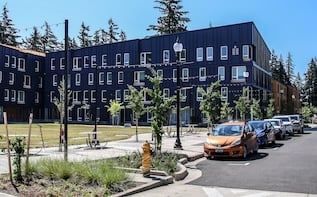- Home
- Environmental Services
- Transportation Division
- Summer Roadwork
Summer Roadwork
Summer road maintenance is scheduled June-August. The scheduled repairs extend the life of a road at a reduced cost. To find out where crews are working, check the map below.
West Powell Blvd. (between Eastman Parkway and SE 174th Ave)
- Paving is complete on West Powell Blvd.
- Crews are completing signal work, lane striping and work in September.
- While work is being completed, there may be temporary lane closures.
Plan ahead and go slow in the zone. Check TriMet bus schedules for any route or stop changes during construction.
Residential projects
During the summer, routine maintenance is scheduled to limit the impacts of sun and water by repairing cracks, patching the pavement and applying a slurry seal.
Slurry seal work
A slurry seal is the application of water, asphalt emulsion, aggregate (small, crushed rock) and additives to existing pavement. This method is used to preserve and protect the underlying pavement structure.
Residential slurry seal work is completed in July and August.
Notification of work
- Notices are sent to property owners to trim trees and shrubs in preparation for upcoming work.
- A postcard is mailed to affected residents prior to resurfacing work.
- 24 - 48 hours before the work begins, "No Parking" signs are placed on your street. The signs will include the dates of construction.
- We also leave a door hanger with more information when we post the "No Parking" signs.
Work hours
- Work hours: 7:00 am-5:00 pm
The day of the slurry
- Do not wash your car or water your lawn on the day of the slurry. The street must stay dry.
- The street is closed to all traffic.
- Crews will sweep the road and place utility covers.
- Cones are placed at driveways to show the street is closed.
- Large trucks will spread the slurry across the whole road.
- The slurry will be wet and sticky at first. It takes 4 - 6 hours to dry, depending on the weather.
- Until the seal cures, the street is closed to cars, bikes, pets, and people.
- Do not leave your driveway during this time.
- When the work is complete, the cones, barricades, and “No Parking” signs are removed.
Please note: Vehicles parked on a street with "No Parking" signs, during any phase of construction, will be towed. Every effort is made to contact residents prior to the construction date. If your vehicle is towed, contact the Gresham Police Department at 503-618-2318.
Garbage service
The City is coordinating work with local garbage haulers. If work is scheduled on your garbage day, we recommend putting your roll carts out early to allow haulers to collect garbage prior to road work.
Crews worked throughout Gresham to repair local streets. Slurry seal work was completed in the following neighborhoods:
- Centennial
- Central City
- Gresham Butte
- Historic Southeast
- Hollybrook
- North Gresham
- Northwest
- Rockwood
- Southwest
- Wilkes
Slurry seal
Slurry seal work is weather dependent. If it rains, work will be rescheduled. Check the roadwork map to see where crews are working.
How do we decide what streets get maintenance?
Regular maintenance extends the life of the street. Slurry seal and crack sealing help block water and protect the road from damage. Our maintenance program helps streets last longer and saves money by avoiding costly repairs later.
Work is weather dependent
If it rains or rain is expected, crews will stop and reschedule the work. The online map is updated with new dates.
How you can help get ready for the work
- Move your car off the street before work starts.
- Keep sidewalks and driveways clear.
- Trim plants or trees that hang into the street.
- Follow “No Parking” signs and other posted notices.
- Stay off the road while work is happening.
- Avoid watering your lawn or washing your car. Water can ruin the new slurry surface.
- Plan ahead. Your street will be closed the day of the slurry. If you need to leave after 7 am, park on a nearby street.
Why trim trees and plants?
Crews need room to work. Branches should not hang lower than 12 feet above the street. Shrubs and other plants need to be trimmed behind the curb to keep the street clear.
How will I know when the work is done?
- The “No Parking” signs are removed when work is finished.
- Crews and equipment are gone.
- The street is open again.
- Street condition after slurry
- The street might still be soft for a few weeks, so please avoid hard braking, fast starts, or sharp turns.
- It is normal to see some loose rocks after the slurry seal is applied. These small rocks will move to the edges of the road and get swept up within a few days.
Emergency vehicle access
Emergency vehicles will still be able to access your street if needed.
Garbage, mail and package delivery
No vehicles can enter the street until the barricades are removed - unless there is an emergency. If the slurry seal happens on your garbage day, put your bins out by 6:00 am. so they can be emptied before work starts. The post office will be notified, but your mail might be delayed by a day.
Life of a road
Roads have a life span and the life cycle of a road is affected by many factors, including weather, traffic volume and the maintenance efforts that go into preserving the road as long as possible. When a road reaches the end of its life – when surface damage becomes so severe that the road bed is destroyed – it becomes necessary to replace the road, which costs up to $120 per square yard.





